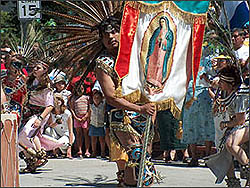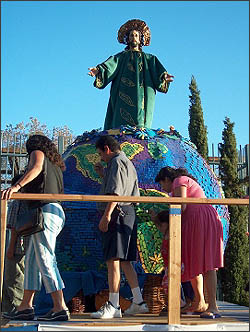| 
Professor Studies 'La Bajada'
Among L.A. Salvadorans
by Valerie Orleans
From Dateline (February 5, 2004)
|

Aztecas dance at "La Bajada"
festival.
photo courtesy of Solano |
Los Angeles is home to an ever-growing population
of Salvadoran immigrants. And while most are happy to be in America,
there is still a longing for their country and the loved ones they
left behind.
“For Salvadorans – many who are here
because of political turmoil and unrest in their native country
– celebrating traditions from El Salvador means a great deal,”
said Jeanette Reedy Solano, assistant professor of comparative religion.
“Today, almost one-fifth of Salvadorans live outside El Salvador,
most in America. And of those, 58 percent live in Los Angeles County.”
Solano studies how religion is incorporated into
the cultural lives of Latin Americans. Her interest began when she
was introduced to the concepts of liberation theology while pursuing
her doctoral studies at the University of Chicago’s Divinity
School.
“For people from countries where there is a
great deal of political unrest, religion and politics often go hand-in-hand,”
she explained. “And particularly in countries such as El Salvador
– where martyrs are frequently religious figures, such as
Oscar Romero or the Maryknoll nuns that were killed by members of
the militia – people have great reverence for religious traditions
based not only on great faith but because they believe that Jesus
and the saints understand their suffering.”
Not only do Salvadorans revere their patron saint,
El Divino Salvador, many who arrived in this country 20 years ago
are concerned that their children do not understand or appreciate
their heritage and traditions.
For that reason, when the Salvadoran American National
Association commissioned a replica of El Divino Salvador (the original
is housed in the national cathedral in San Salvador) to be brought
to Los Angeles, there was cause for great celebration among the
local Salvadoran community.
“Each year in El Salvador, they celebrate La
Bajada,” said Solano. “It’s almost on the same
level as Christmas. The holiday features the statue of El Divino
Salvador, dressed in purple robes, being lowered into a papier-mâché
and tape globe. On the globe itself, no borders are indicated –
only continents. After a few minutes El Salvador reemerges, this
time dressed in white to represent the transfiguration. As the statue
emerges, the crowd cries out, ‘Viva El Salvador!’ which
has two meanings – praise for both the savior and for their
country of origin.
“To see the La Bajada ceremony attract more
attention each year is quite gratifying,” she said. “I
see how traditions change as they move across the border and how
they affect the lives of those immigrants who live here. The aura
of meaning for most Salvadorans is one of struggle, migration and
rootlessness.”

Statue of El Divino Salvador |
After the statue of El Divino Salvador was made, it
became a pilgrim too. As it traveled through El Salvador (in the
back of a red pickup truck), residents gathered to touch the image,
hopeful that their loved ones in America would be able to do the
same.
“The statue became a symbol of love and hope
between family members and loved ones despite the fact that they
are separated by thousands of miles,” Solano said. “When
the statue arrived at Dolores Mission in Boyle Heights, a thoroughly
Mexican area, it was greeted by mariachis and a crowd of 2,000.
Each year, the daylong religious/cultural celebration grows. For
instance, this summer’s La Bajada ceremony was attended by
more than 20,000.
“The symbol of El Divino Salvador is especially
powerful for displaced Salvadorans, migrants and those whose families
are split between two countries,” Solano said. “To have
the opportunity to study and celebrate with these brave people is
truly a privilege.”
« back to People
|